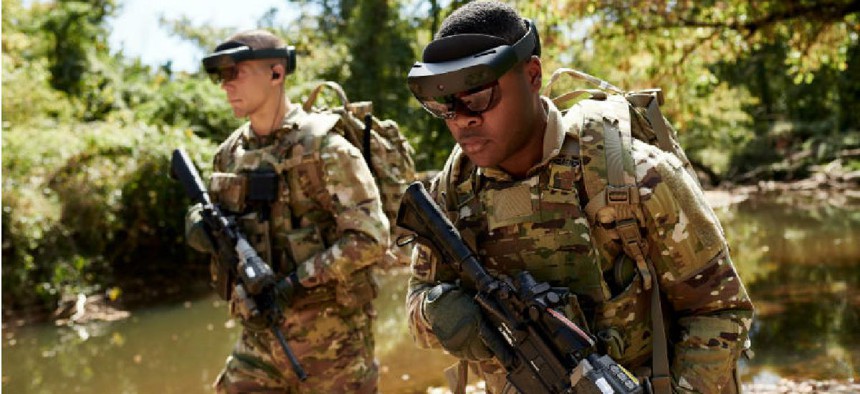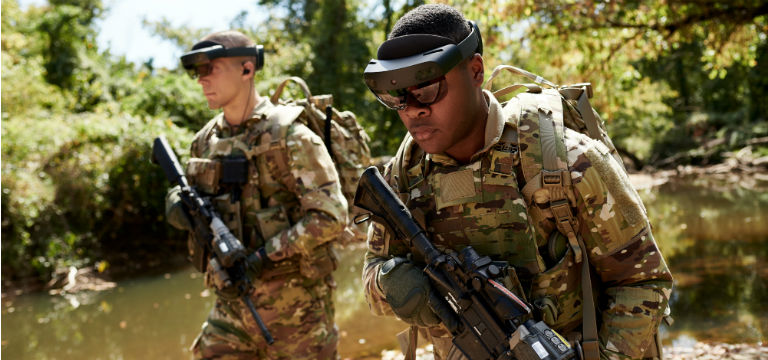Augmented reality headset is the breakout star of Army's 2021 budget request

The Army's focused on finding savings so it can boost modernization funding and the 2021 budget request shows how it wants the initial fielding of augmented reality night goggles to stand out.

Integrated Visual Augmentation System (IVAS) capability set during an exercise at Fort Belvoir, VA in Fall 2019. (Army photo by Courtney Bacon)
The Army's budgeting process has endured shakeups over the past few years thanks to the zero-based budgeting process called "night court" -- and the 2021 $178 billion request is no different.
But with an increased focus on modernization, this year's request has a clear standout: the initial fielding of augmented-reality infused night goggles called IVAS.
Lt. Gen. Thomas Horlander, Military Deputy to the Assistant Secretary of the Army (Financial Management and Comptroller) said at an Association of the U.S. Army event Feb. 18 that such tech investments were key to the "deterrence factor."
"We've done a pretty vast redistribution of funding within that [research, development and acquisition] portfolio," Horlander told reporters following the event. "It's the deterrence factor. Nobody goes and picks a fight with a guy they know they can't beat up," he said. "So to have all these capabilities at a good state of maturity, that's what we've got to achieve."
The Army wants to procure 40,219 Integrated Visual Augmentation System units that overly data, including map displays and simulated images for training. The heads up display is also connected to a soldier's weapon sensor onto a single platform that also combines individual assessment and biometrics information.
Those units are expected to go to 100,000 close combat forces, Maj. Gen. Paul Chamberlain, the Army's budget director told reporters Feb. 11, who will use IVAS in the course of their normal training events.
The Army has been testing and developing the system since 2018 and no units are slated to be purchased in fiscal 2020. The final version of the heads up display, based on the Microsoft Hololens 2, will likely be fielded by the end of fiscal 2021.
Such tech investment is largely dependent on other transaction agreements, a mechanism that allows DOD to quickly buy technology. IVAS is an OTA product and a process that Army Secretary Ryan McCarthy said ultimately saves money.
"Contractually it is a little more latitude to work with a contractor to study through prototyping the types of characteristics you want because they may have a better way of getting to the outcome than we want so we were doing this with the IVAS program, we are doing this on our next generation squad weapon," McCarthy said during a Feb. 15 speaking event at the National Press Club.
"So we tried doing it the old way and…we missed pretty big, but we learned a lot. We spent $23 million instead of spending $2.3 billion like we would have done a decade ago."
The Army's research, development, and acquisition portfolio for fiscal 2021 rose slightly (0.3%) but cuts were also made on the tech side.
More than $30 million was cut from the Distributed Common Grounds Systems, an intelligence-based system that helps commanders visualize the operational environments and better understand threats and other relevant aspects of the operational environment, for procurement (20.6 million) and research ($10.5 million) due to a program delay.
Smaller cuts to research dollars for defensive cyber operations ($26,000) and procurement funds for defensive cyber tools ($1.7 million) were due to schedule or operational needs "allowing for program delay." The Army also asked for $11.7 million less in procurement funds for its web-based battlefield encryption program, Key Management Infrastructure, because it has sufficient quantities.
The Army's biggest increases go to personnel pay raises at 4.8% followed by 3.6% in operations and maintenance. But Horlander said that $178 billion ask needs to increase at least 3% every year to keep pace with readiness needs.
Horlander said comprehensive audits, and "deep dives" like the night court process, should be standard to ensure taxpayer money is being well spent, but there will be friction in coming years when more than 30 of the Army's signature modernization programs enter prototyping -- unless the budget increases at least 3% every year.
"There are some real difficult decisions on the horizon," Horlander said. "Some of these modernization programs, when we start to pilot them, then we start to want to field them, that's when we're going to see some really tough decisions made."
There are 34 signature programs. Most of them, if not all of them, are on a very good course," with prototypes scheduled to come out in 2023 and fielded in 2025.
The Army said it had $1.4 billion reforms savings that matched the Pentagon's requirements and had more than $1 billion in other savings thanks to the recently adopted zero-budgeting or night court process. The Army said its cost-savings were reinvested and used to fund the Cross Functional Teams' modernization efforts, such as network and soldier lethality capabilities like IVAS.



